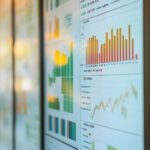Zennemis – Python for Data & Analytics. Have you ever wondered how top companies use their data to beat the competition? In today’s fast business world, Python for data & analytics is key to winning. It’s not just a trend; it’s a must-have for success.
We’ll look at how Python changes the game in business analytics. Its easy-to-use syntax and strong libraries help us find valuable insights in our data. By using Python for business analytics, we can make smart, data-driven choices. This improves our strategic planning and makes our operations more efficient.
Let’s dive into the exciting mix of python for data science and business. We’ll see how this approach gives us a big edge over the competition.
The Importance of Data in Modern Business
In today’s fast-changing digital world, data is key for businesses to succeed and stay ahead. Being able to gather, process, and analyze huge amounts of data helps us make better decisions and improve how we serve customers. Companies that use data well are 23 times more likely to get new customers, six times more likely to keep their current ones, and 19 times more likely to make a profit, as the McKinsey Global Institute found.
Using advanced analytics is a must for companies wanting to work more efficiently. Companies that use data analytics are 20% more efficient in what they do. By combining data from sales, marketing, HR, and finance, we get a complete picture that helps us make smarter choices. Tools like python data analytics tools are key in making this happen.
Python is the top choice for data analysis because of its strong standard library and community support. It meets the needs of business analytics well, making it easier to see insights, test ideas, and use augmented analytics. Python’s flexibility and wide use make it a go-to for market leaders who want to use their data for the best results.
Understanding Data Analysis with Python
Data analysis is key to making smart business choices. It involves looking at, changing, and modeling data to find important insights. Python is a big help in this field, especially for businesses looking to use data for their benefit.
What is Data Analysis?
Data analysis uses different methods to collect and understand data to spot trends or patterns. This is vital for businesses wanting to make better decisions. By using Python, companies can handle big datasets better and make smarter choices.
The Role of Python in Data Analysis
Python is a top choice for data analysis because it’s flexible and has many libraries for different tasks. It helps teams do complex analyses quickly. Libraries like NumPy and Pandas make working with data easier, and Matplotlib makes results easy to understand.
This makes Python great for beginners and experts alike. It makes data-driven decisions easier for everyone.
| Library | Primary Use | Key Features |
|---|---|---|
| NumPy | Scientific Computing | High-performance multidimensional arrays, arithmetic operations, broadcasting |
| Pandas | Data Manipulation | DataFrames, data cleaning, indexing, filtering |
| Matplotlib | Data Visualization | Graphs, charts, customizable plots |
Using Python for predictive analytics helps businesses predict future trends. This lets them stay ahead of the competition. Python turns data into useful insights for the business world.
Python for Data & Analytics: A Business-Oriented Approach
When we look at python for big data analytics, it’s clear that linking our data work with business goals is key. Knowing how to use this powerful language helps us make the most of our data. It lets us build systems that use data well and promote making decisions based on data in our companies.
By focusing on clear goals, we can make our work smoother and improve our big plans. Using python data visualization tools helps turn hard data into clear insights. This makes it easier for those in charge to understand important details. With clear pictures, we improve our analysis, giving us a deeper look into market trends and what customers do.
| Aspect | Traditional Methods | Using Python for Data Analytics |
|---|---|---|
| Data Processing Speed | Often slow and manual | Automated, faster processing |
| Scalability | Limited scalability | Easily scalable to big data |
| Data Visualizations | Basic charts and graphs | Dynamic and interactive visuals |
| Decision-Making | Gut-feeling based | Data-informed decisions |
Using these methods helps us get the most from our data. It makes sure our analytics work helps the business grow in a real way.
Key Python Libraries for Data Analytics
Python is a powerful tool for data analytics, thanks to several key libraries. These libraries help us in data manipulation, scientific computing, and visualization. They are crucial for anyone wanting to get into analytics or make better data-driven decisions.
NumPy for Scientific Computing
NumPy is the go-to package for scientific computing in Python. It has about 18,000 comments on GitHub and is supported by 700 contributors. It’s essential for numerical operations, linear algebra, and statistical analysis. NumPy makes handling large arrays and matrices easy, making it a key tool for data analysis.
Pandas for Data Manipulation
Pandas is known for its top-notch data manipulation skills. It has around 17,000 comments on GitHub and a community of 1,200 contributors. This library makes data cleaning, transformation, and analysis easier. It’s a favorite among practitioners for its ease of use.
Matplotlib for Data Visualization
Matplotlib is vital for creating visualizations in Python. It has about 26,000 comments and a community of 700 contributors. This library helps us show data insights through graphs. When combined with libraries like Seaborn and Plotly, it lets us tell complex data stories clearly.
| Library | GitHub Comments | Community Contributors | Main Functions |
|---|---|---|---|
| NumPy | 18,000 | 700 | Numerical operations, linear algebra, statistical analysis |
| Pandas | 17,000 | 1,200 | Data manipulation, cleaning, exploration |
| Matplotlib | 26,000 | 700 | Data visualization, creating static and animated plots |
Understanding these libraries gives us the tools we need to tackle data analytics. Each library has unique features for different tasks. They are all crucial for effective data analysis.
How Python Enhances Decision-Making in Business
Today’s businesses look for ways to make better decisions. Using Python for business analytics is key to this goal. Python’s efficiency and flexibility help businesses quickly analyze complex data. This gives real-time insights into customer behavior, market trends, and how operations are doing.
Data analysis is vital for today’s businesses. It helps us make smart choices in a competitive world. With Python, we can manage and analyze data better. This improves our ability to find insights that lead to action. Libraries like NumPy and Pandas are crucial. NumPy does fast math, and Pandas makes handling data easier, helping us spot important patterns.
Python does more than just simple analytics. It lets businesses predict future trends. This helps us plan better and manage risks. It makes operations more efficient and helps us grow profits.
Python is easy to learn, making it popular for data analytics. Many schools offer Python training for data analysis jobs. This means people without tech backgrounds can use data science too.
By using Python’s analytical power, we make better decisions. We turn data into valuable insights. This helps us handle the challenges of modern business with confidence.
Real-World Case Studies of Python in Business Analytics
Python is a key tool in business analytics, helping many industries with its data mining and predictive analytics skills. We’ll look at examples showing how companies use Python for data mining and predictive analytics to succeed.
Data Mining Applications
Companies see the value of using Python for data mining to find insights in big datasets. For example, Netflix uses Python to understand user behavior. This helps them make recommendations that make customers happier and more engaged. Amazon also uses Python to make marketing strategies and product suggestions better, keeping customers coming back.
Predictive Analytics and Business Intelligence
Predictive analytics with Python is key for making smart choices in many businesses. Coca-Cola uses it to make marketing better aimed at certain customers, which gets more people involved. In healthcare, Python helps make predictions, like with IBM Watson, to prevent diseases and improve patient care.
| Company | Application | Impact |
|---|---|---|
| Netflix | User behavior analysis | Enhanced customer satisfaction through personalized recommendations. |
| Amazon | Product recommendation optimization | Increased customer loyalty and sales through targeted marketing. |
| Coca-Cola | Predictive marketing strategies | Improved customer engagement with customized initiatives. |
| IBM Watson | Disease prevention and early intervention | Enhancement of patient outcomes in healthcare. |
These examples show how Python’s data mining and predictive analytics are changing businesses. As companies keep using these tools, they’ll make better decisions and grow even more.
Challenges of Using Python for Business Data Analysis
Python is a top choice for data analytics, but it comes with challenges. One big issue is dealing with data quality. This can lead to data analytics pitfalls like incomplete or wrong data, which messes up the analysis.
Adding Python to a business can be tough. It needs to work with different databases and data formats. This can slow things down. Also, learning Python is hard for beginners. Even though there’s a lot of help out there, getting good at it takes time and effort.
To beat these challenges in python analytics, businesses should use structured data analysis workflows. These frameworks help us work in a systematic way and make sure we do things the same way every time. Setting clear goals at the start helps us stay focused and avoid problems later on.
| Challenge | Description | Potential Solutions |
|---|---|---|
| Data Quality Issues | Inaccurate or incomplete datasets affect analysis outcomes. | Regular data audits and validation processes. |
| Integration Complexities | Difficulty in merging Python with existing systems and databases. | Utilize APIs and tools that facilitate smooth integration. |
| Steep Learning Curve | New users may struggle to adapt to Python and its libraries. | Offer training programs and utilize community resources. |
| Data Management | Handling large datasets can be cumbersome without the right strategies. | Employ efficient data management tools and practices. |
With careful planning and the right strategies, we can lessen the effects of these challenges. Navigating the complexities of using Python for business data analysis can help organizations make the most of their data efforts.
Conclusion
Today, using Python analytics in business is crucial for staying ahead. Python stands out in data analysis for its ease of use, flexibility, and strong libraries like Pandas and NumPy. These tools help us work with big data and find insights that improve our decisions.
Companies like Netflix, Google, and Uber show Python’s bright future in business. With new tools and libraries coming up, Python can help us grow and keep up with the changing data world. But, we need to be aware of the challenges and work together to use Python well in our companies.
To make the most of Python, we must keep learning and use tools like Apache Spark or Hadoop. By improving our skills and setting clear goals, we stay ahead in business analytics. This leads to ongoing success in the market.
FAQ
What makes Python a popular choice for data analytics in business?
Python is easy to use and has lots of libraries like NumPy, Pandas, and Matplotlib. These tools help us work with big datasets and find important insights. This leads to better decisions in business.
How can businesses leverage Python for predictive analytics?
Python’s strong libraries and machine learning tools help businesses analyze past data. This lets them predict future trends and customer actions. Knowing what might happen helps in making smart business choices and planning.
What are the main challenges of using Python for business data analytics?
Python has many benefits, but it also has challenges. Issues include poor data quality, complex system integration, and a learning curve for new users. To overcome these, it’s important to focus on data management and training.
Which Python libraries are essential for data visualization?
Matplotlib is a top choice for visualizing data, letting us make many types of charts and graphs. Seaborn and Plotly also offer advanced visualization tools. These libraries help us tell stories with our data.
How does a business-oriented approach to Python analytics change outcomes?
Using Python for business means making sure analytics support company goals. This leads to better operations, strategies, and more revenue. It’s all about making data-driven decisions.
Can Python be used for data mining in business?
Yes, Python is great for data mining in business. It helps us find valuable insights in big datasets. With tools like Scikit-learn and NLTK, we can spot patterns and behaviors. This helps us understand customers better and improve our operations.
What role does data analysis play in understanding customer behavior?
Data analysis helps us look at customer interactions, likes, and feedback. Python for data analytics gives us insights into how customers act. This knowledge lets us tailor marketing and improve customer experiences.
Why is it important to foster a data-driven decision-making culture?
A data-driven culture lets employees make choices based on solid data. This encourages ongoing improvement and flexibility. It leads to better strategies and business growth.




